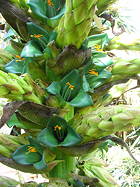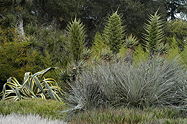One of the standout attractions at the Huntington each April is the flowering of Puya alpestris with its otherworldly, metallic blue-green flowers. The lesser-known runner-up in March is P. berteroniana. Considered by some to be merely a color variant of P. alpestris, P. berteroniana has emerald-green flowers. It also seems to be a more imposing plant with rosettes to 6' across and flower stalks to 8' or more tall. The structure of these stalks is the same, with sterile peduncle branches forming convenient perches for bird pollinators drawn by copious sweet nectar in the flowers which have an odd rancid-butter aroma about them. The plants perform equally well in full sun at the bottom of the Huntington’s Desert Garden, where a few winter frosts in the 20s°F are the norm, as it does in the part shade under the canopy of Aloe barberae trees in the upper garden. HBG 97074, seedlings of HBG 21084, plants collected Dec 8, 1966, by H.A. Mooney (SA # 11) in the Quebrada de la Plata, Chile. Limited, one per customer, $15.
Zizka et al. have clarified the application of this name in a recent revision of Chilean puyas in Brittonia (July 9, 2013, online). The name P. berteroniana applies to a very rare natural hybrid of P. alpestris with a species of the P. coerulea group so should properly be P. ×berteroniana. The authors also clarify the spelling used here rather than the sometimes seen P. berteroana. What has been widely grown as P. berteroniana represents a northerly variant of P. alpestris described in this paper as P. alpestris subsp. zoellneri so this is the appropriate name for ISI 2010-26.

Published in the Cactus and Succulent Journal, Vol. 82 (2), March - April, 2010

